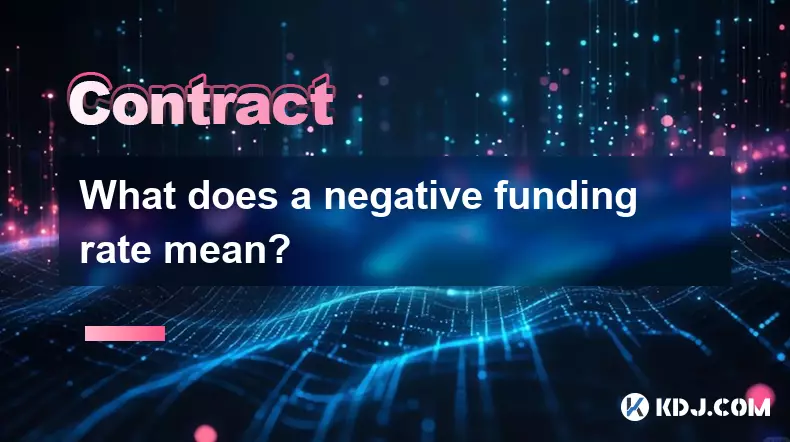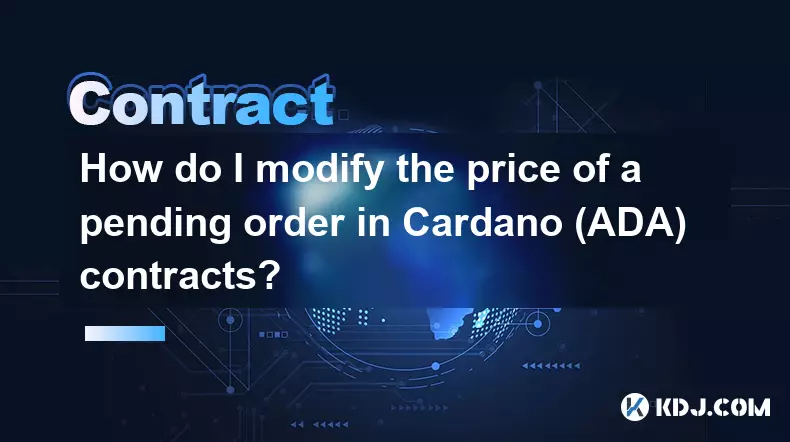-
 bitcoin
bitcoin $109667.069529 USD
-3.03% -
 ethereum
ethereum $3936.685804 USD
-4.07% -
 tether
tether $1.000493 USD
0.01% -
 xrp
xrp $2.771823 USD
-4.74% -
 bnb
bnb $957.805027 USD
-5.34% -
 solana
solana $196.735100 USD
-6.68% -
 usd-coin
usd-coin $0.999727 USD
-0.01% -
 dogecoin
dogecoin $0.227355 USD
-5.12% -
 tron
tron $0.335205 USD
-0.81% -
 cardano
cardano $0.779256 USD
-3.59% -
 ethena-usde
ethena-usde $0.999900 USD
-0.06% -
 hyperliquid
hyperliquid $42.492095 USD
-6.61% -
 chainlink
chainlink $20.501853 USD
-4.34% -
 avalanche
avalanche $28.952606 USD
-11.21% -
 stellar
stellar $0.356038 USD
-3.93%
What does a negative funding rate mean?
A negative funding rate means long traders pay shorts, signaling bearish sentiment and encouraging market balance in crypto perpetual contracts.
Sep 12, 2025 at 11:54 pm

Negative Funding Rate Explained
1. A negative funding rate in the cryptocurrency derivatives market indicates that traders holding long positions pay those holding short positions. This mechanism is built into perpetual swap contracts to keep the market price aligned with the underlying asset’s spot price. When the funding rate turns negative, it often reflects a market sentiment where selling pressure outweighs buying interest.
2. The calculation of the funding rate typically combines the interest rate component and the premium index, which accounts for the price difference between the perpetual contract and the spot market. If the perpetual contract trades below the spot price, known as backwardation, the funding rate tends to go negative. This encourages traders to open long positions, helping to balance the market.
3. Traders who maintain long positions on exchanges during periods of negative funding must pay a periodic fee to short holders. This cost can accumulate over time, especially for leveraged positions. As a result, long traders may exit their positions or reduce exposure, further reinforcing the bearish sentiment in the market.
4. A sustained negative funding rate often signals weak bullish momentum. It suggests that despite some buying activity, the broader market structure favors sellers. This condition is commonly observed during market corrections or bearish trends when fear and uncertainty dominate trader psychology.
5. Market makers and arbitrageurs monitor funding rates closely. A deeply negative rate may attract traders looking to earn passive income by holding short positions. However, this strategy carries risk, as sudden price reversals can trigger liquidations even if the funding rate is favorable.
Market Implications of Negative Funding
1. A negative funding rate can act as a self-correcting mechanism. By incentivizing shorts and penalizing longs, it helps prevent excessive leverage buildup on the long side, which could lead to cascading liquidations during downturns. This balance contributes to market stability over time.
2. In highly volatile markets, negative funding rates may persist even during price rebounds. This divergence indicates that traders remain cautious and are not fully committing to bullish positions. The lingering negative rate suggests that the recovery might lack strong conviction.
3. Exchanges publish funding rates at regular intervals, usually every eight hours. Traders use this data to adjust their strategies. For instance, a trader might avoid opening a long position if the funding rate is significantly negative, anticipating ongoing costs that could erode profits.
4. Some trading bots are programmed to exploit funding rate differentials across exchanges. If one platform shows a deeply negative rate while another does not, arbitrage opportunities emerge. These bots can shift positions to capture the yield without taking directional risk.
5. Prolonged negative funding can influence sentiment indicators. When combined with low open interest and declining volume, it often points to a lack of participation from aggressive bulls. This environment may precede consolidation or further downside movement.
Trader Behavior During Negative Funding
1. Sophisticated traders often interpret negative funding rates as a contrarian signal. If the rate becomes extremely negative while prices stabilize, it may indicate oversold conditions. Some traders use this as a cue to enter long positions, anticipating a reversal as shorts are forced to cover.
2. Retail traders frequently overlook funding costs, focusing only on price direction. This oversight can lead to unexpected losses, especially in prolonged bear markets where negative funding accumulates over days or weeks. Education around funding mechanics is critical for risk management.
3. Institutional participants tend to factor funding rates into their execution models. They may delay entering long positions until the funding rate normalizes, avoiding periods of high carry cost. Their disciplined approach often results in better risk-adjusted returns.
4. Short-term scalpers may ignore funding rates altogether, relying on quick entries and exits. Since funding is paid periodically, traders who hold positions for minutes or hours are largely unaffected. However, this strategy fails when positions are held overnight during volatile funding cycles.
5. Traders who consistently monitor and adapt to negative funding environments can gain a strategic edge by aligning their positions with market incentives rather than fighting them.
Frequently Asked Questions
How often is the funding rate applied?Funding payments are typically settled every eight hours on most major cryptocurrency derivatives exchanges. The exact timing is standardized to specific UTC intervals, such as 00:00, 08:00, and 16:00.
Can funding rates predict price movements?Funding rates alone are not reliable predictors of price direction. However, extreme values—either deeply negative or positive—can signal overleveraged conditions that may precede sharp reversals due to liquidations.
Do all crypto derivatives have funding rates?No. Funding rates apply only to perpetual futures contracts. Traditional futures contracts and spot trading do not involve funding payments, as they settle at expiration or immediately.
What happens if I close my position before funding settlement?If a trader closes their position before the funding timestamp, they do not owe or receive any funding payment for that period. Only traders with open positions at the settlement moment are affected.
Disclaimer:info@kdj.com
The information provided is not trading advice. kdj.com does not assume any responsibility for any investments made based on the information provided in this article. Cryptocurrencies are highly volatile and it is highly recommended that you invest with caution after thorough research!
If you believe that the content used on this website infringes your copyright, please contact us immediately (info@kdj.com) and we will delete it promptly.
- APEX Token & LCX Exchange: Listing Trends and Insights
- 2025-09-27 00:45:16
- DRV Token's Wild Ride: Dilution, Debate, and the LCX Exchange Listing
- 2025-09-27 00:45:16
- Ruvi AI's Solana Surge: Daily Sales Explode, Leaving Giants Behind
- 2025-09-27 00:50:01
- Aster Exchange's XPL Token Price Glitch: What Happened?
- 2025-09-27 01:05:16
- Aster Exchange's XPL Token Price Glitch: A Deep Dive into the $4 Flash
- 2025-09-27 00:50:01
- Plasma Mainnet Launch Surge: XPL Token Skyrockets with Binance, Tether, and Chainlink Support
- 2025-09-27 01:20:18
Related knowledge

How do I enable the "scalping-only" mode for Cardano (ADA) contracts?
Sep 24,2025 at 03:19am
Understanding Scalping Strategies in Crypto Derivatives1. Scalping in cryptocurrency trading refers to executing multiple short-term trades within min...

What is the maximum position limit for Cardano (ADA) contracts?
Sep 23,2025 at 11:00pm
Understanding ADA Futures and Derivatives Market Structure1. Cardano (ADA) futures contracts are offered by several major cryptocurrency derivatives e...

What is the maker fee for Cardano (ADA) contracts?
Sep 26,2025 at 09:01am
Understanding Maker Fees in Cardano (ADA) Contracts1. The concept of maker fees applies broadly across decentralized exchanges and smart contract plat...

How can I view open interest in Cardano (ADA) contracts?
Sep 24,2025 at 07:36am
Understanding Open Interest in Cardano Derivatives1. Open interest refers to the total number of outstanding derivative contracts, such as futures or ...

How do I modify the price of a pending order in Cardano (ADA) contracts?
Sep 27,2025 at 01:00am
Understanding Pending Orders in Cardano Smart Contracts1. Cardano operates on a proof-of-stake blockchain that supports smart contracts through its Pl...

What is the function of the insurance fund in Cardano (ADA) contracts?
Sep 24,2025 at 02:18am
Understanding the Role of Insurance Funds in Cardano Smart Contracts1. The insurance fund within Cardano's ecosystem is not a native feature directly ...

How do I enable the "scalping-only" mode for Cardano (ADA) contracts?
Sep 24,2025 at 03:19am
Understanding Scalping Strategies in Crypto Derivatives1. Scalping in cryptocurrency trading refers to executing multiple short-term trades within min...

What is the maximum position limit for Cardano (ADA) contracts?
Sep 23,2025 at 11:00pm
Understanding ADA Futures and Derivatives Market Structure1. Cardano (ADA) futures contracts are offered by several major cryptocurrency derivatives e...

What is the maker fee for Cardano (ADA) contracts?
Sep 26,2025 at 09:01am
Understanding Maker Fees in Cardano (ADA) Contracts1. The concept of maker fees applies broadly across decentralized exchanges and smart contract plat...

How can I view open interest in Cardano (ADA) contracts?
Sep 24,2025 at 07:36am
Understanding Open Interest in Cardano Derivatives1. Open interest refers to the total number of outstanding derivative contracts, such as futures or ...

How do I modify the price of a pending order in Cardano (ADA) contracts?
Sep 27,2025 at 01:00am
Understanding Pending Orders in Cardano Smart Contracts1. Cardano operates on a proof-of-stake blockchain that supports smart contracts through its Pl...

What is the function of the insurance fund in Cardano (ADA) contracts?
Sep 24,2025 at 02:18am
Understanding the Role of Insurance Funds in Cardano Smart Contracts1. The insurance fund within Cardano's ecosystem is not a native feature directly ...
See all articles










































































